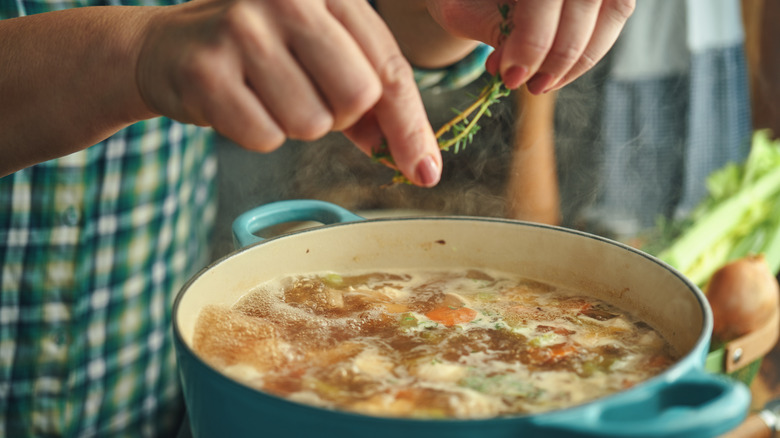Why It's Important To Layer Ingredients When Making Soup
A pot of simmering soup is the ultimate symbol of comfort food, but you don't get that perfect homey flavor without layering your ingredients. Soup is something homemade — an unfancy, unpretentious throwing of ingredients into liquid to produce a hearty, filling meal. However, part of what makes soup good is how complex the flavor can be. That broth slowly absorbs the flavor of everything that goes into it, becoming something entirely new that is greater than the sum of its parts. That only happens with proper layering.
Layering can refer to both the combination of flavors you are putting in your meal and the order in which you add those flavors. It's not just the what, but the when, and while both matter for soup, it's the order of incorporation that can get overlooked. It's important because the long cooking time has a very different effect on ingredients, drawing more taste from some while muting others, and making tough foods tender while turning others to mush. Fresh herbs added at the end of cooking will bring a clear pop of bright flavor, but add them at the beginning or middle and they will fade into the background. So knowing that ideal layering order is key, and the first step with soup is cooking the ingredients that do best with high heat before the water or stock gets added.
Know when to add each ingredient for the most flavorful soup
Your soup layering begins with anything hearty that you want to be browned — for texture and taste. Meat is the most obvious, as searing the outside will develop way more flavor not only on the meat itself, but also in the bits that get absorbed into your broth. Aromatic vegetables also benefit from browning, as the heat will draw out more complex sweetness from carrots or onion. The last step, pre-stock, is dried herbs and spices. Cooking them in direct heat adds to their taste by helping their flavor bloom, but they should only be cooked for a minute to avoid burning.
Once you've added your liquid, your tougher vegetables will be the first in the pot. This is the time for things like potatoes or broccoli, which will take time to cook, soften, and lend their flavor to the broth. Later additions are more tender vegetables like leafy greens or ingredients like meatballs, which would get waterlogged and break down from long cooking.
Finally you have the end of cooking garnishes that don't benefit from too much heat. Fresh herbs are one, this is also the time to adjust the taste of your soup with acids like vinegar or citrus juice. This is also when things like cream or beaten egg can be added for richness without the risk of curdling from overcooking. Treating every ingredient as an individual is the best way to get them working together.

